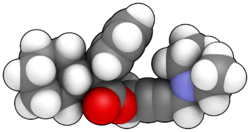Oksibutinin

| |||

| |||
| (IUPAC) ime | |||
|---|---|---|---|
| 4-Dietilaminobut-2-inil 2-cikloheksil-2-hidroksi-2-feniletanoat | |||
| Klinički podaci | |||
| Robne marke | Ditropan | ||
| AHFS/Drugs.com | Monografija | ||
| MedlinePlus | a682141 | ||
| Identifikatori | |||
| CAS broj | 5633-20-5 | ||
| ATC kod | G04BD04 | ||
| PubChem[1][2] | 4634 | ||
| DrugBank | APRD00427 | ||
| ChemSpider[3] | 4473 | ||
| UNII | K9P6MC7092 | ||
| KEGG[4] | D00465 | ||
| ChEBI | CHEBI:7856 | ||
| ChEMBL[5] | CHEMBL1231 | ||
| Hemijski podaci | |||
| Formula | C22H31NO3 | ||
| Mol. masa | 357,486 g/mol | ||
| SMILES | eMolekuli & PubHem | ||
| |||
| Farmakokinetički podaci | |||
| Vezivanje za proteine plazme | 91%-93% | ||
| Poluvreme eliminacije | 12,4-13,2 sata | ||
| Farmakoinformacioni podaci | |||
| Trudnoća | ? | ||
| Pravni status | Rx Only (CA)[6], Rx Only (US) | ||
| Način primene | oralno, transdermalno | ||
Oksibutinin (Ditropan, Lirinel XL) je antiholinergijski lek koji se koristi za olakšavanje urinarnih problema, što obuhvata frekventno mokrenje i nesposobnost kontrole urinacije. On deluje putem umanjenja mišićnih spazama bešike.[7] Oksibutinin je kompetitivni antagonist M1, M2, i M3 podtip muskarinskog acetilholinskog receptora. On isto tako ima direktno spazmolitičko dejstvo na glatke mišiće bešike kao kalcijumski antagonist i lokalni anestetik, mada pri koncentracijama koje su daleko iznad onih koje se koriste u kliničkoj praksi. On je dostupan za oralnu primenu kao generička formulacija i pod brand imenima Ditropan i Lyrinel XL. On je isto tako na tržištu u obliku transdermalnog flaster pod imenom Oksitrol, i kao topikalni gel pod imenom Gelnique.
Oksibutinin je takođe mogući tretman za hiperhidrozu, ili hiperaktivno znojenje.[8][9][10]
Stereokemija[uredi | uredi kod]
Oxybutynin sadrži stereocentar i sastoji se od dva enantiomera. Ovo je racemat, tj. 1: 1 smjesa (R) - i (S) -form:[11][12]
| Enantiomeri oksibutinina | |
|---|---|
 CAS-Nummer: 119618-21-2 |
 CAS-Nummer: 119618-22-3 |
Reference[uredi | uredi kod]
- ↑ Li Q, Cheng T, Wang Y, Bryant SH (2010). „PubChem as a public resource for drug discovery.”. Drug Discov Today 15 (23-24): 1052-7. DOI:10.1016/j.drudis.2010.10.003. PMID 20970519.
- ↑ Evan E. Bolton, Yanli Wang, Paul A. Thiessen, Stephen H. Bryant (2008). „Chapter 12 PubChem: Integrated Platform of Small Molecules and Biological Activities”. Annual Reports in Computational Chemistry 4: 217-241. DOI:10.1016/S1574-1400(08)00012-1.
- ↑ Hettne KM, Williams AJ, van Mulligen EM, Kleinjans J, Tkachenko V, Kors JA. (2010). „Automatic vs. manual curation of a multi-source chemical dictionary: the impact on text mining”. J Cheminform 2 (1): 3. DOI:10.1186/1758-2946-2-3. PMID 20331846.
- ↑ Joanne Wixon, Douglas Kell (2000). „Website Review: The Kyoto Encyclopedia of Genes and Genomes — KEGG”. Yeast 17 (1): 48–55. DOI:10.1002/(SICI)1097-0061(200004)17:1<48::AID-YEA2>3.0.CO;2-H.
- ↑ Gaulton A, Bellis LJ, Bento AP, Chambers J, Davies M, Hersey A, Light Y, McGlinchey S, Michalovich D, Al-Lazikani B, Overington JP. (2012). „ChEMBL: a large-scale bioactivity database for drug discovery”. Nucleic Acids Res 40 (Database issue): D1100-7. DOI:10.1093/nar/gkr777. PMID 21948594.
- ↑ „Product Information”. Drug Product Database. Pristupljeno 13. 8. 2011.[mrtav link]
- ↑ Chapple CR. "Muscarinic receptor antagonists in the treatment of overactive bladder". Urology (55)5, Supp. 1:33-46, 2000.
- ↑ Tupker RA, Harmsze AM, Deneer VH (2006). „Oxybutynin therapy for generalized hyperhidrosis.”. Arch Dermatol 142 (8): 1065–6. DOI:10.1001/archderm.142.8.1065. PMID 16924061.
- ↑ Mijnhout GS, Kloosterman H, Simsek S, Strack van Schijndel RJ, Netelenbos JC. (2006). „Oxybutynin: dry days for patients with hyperhidrosis.”. Neth J Med 64 (9): 326–8. PMID 17057269.
- ↑ Schollhammer M, Misery L. (2007). „Treatment of hyperhidrosis with oxybutynin.”. Arch Dermatol. 143 (4): 544–5. DOI:10.1001/archderm.143.4.544. PMID 17438194.
- ↑ Kachur JF, et al. R and S enantiomers of oxybutynin: pharmacological effects in guinea pig bladder and intestine, Journal of Pharmacology and Experimental Therapeutics, 247, S. 867–872, 1988; PMID 2849672.
- ↑ Noronha-Blob L, Kachur JF. Enantiomers of oxybutynin: in vitro pharmacological characterization at M1, M2 and M3 muscarinic receptors and in vivo effects on urinary bladder contraction, mydriasis and salivary secretion in guinea pigs, Journal of Pharmacology and Experimental Therapeutics, 256, S. 562–567, 1991; PMID 1993995.